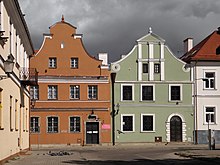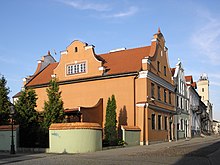Dom Esterki (Radom)
Dom Esterki (also Dom Esterka , German House of Esther ) is a listed residential building in the Baroque style in Radom in the Masovian Voivodeship in Poland . The building is located in the Miasto Kazimierz (Kasimir's City) district , which is named after Casimir the Great . Legends connect him and Charles X Gustav of Sweden to this house.
Location and history
Casimir the Great founded the new Radom in the north of the early medieval old town in 1350 ( Polish: Stare Miasto) and in 1364 granted it Magdeburg town charter . During his reign, the town hall was built on the elongated market square (Rynek) in the central part of the north side of the square. The Russian governor had the building demolished in 1818. It was replaced 30 years later by a neo-Renaissance town hall . The Dom Esterki is in the northwest corner of the market square. With it, 15 buildings on the market are listed.
The old house was destroyed by the Swedes in the Second Northern War . A new baroque style building was erected in the second half of the 17th century. In 1919 the Rosenblat family is proven to be the owner. During the Second World War , the house was demolished by the German occupiers. Only remnants remained of the ground floor and basement. These were removed in the 1950s and the house was rebuilt from 1953 to 1955 based on a design by a Radom architect.
The Gąski (Rynek 4) and Esterki (Rynek 5) houses became the seat of the Museum of Contemporary Art , which was founded in 1990 as a branch of the District Museum (Muzeum Okręgowe). After the Radom Voivodeship, which had existed since 1975, became part of the Masovian Voivodeship in 1999, the museum lost its national status and was renamed the Jacek Malczewski Museum . The museum is controlled by the Ministry of Culture and National Heritage .
According to a proposal by Andrzej Wajda , the city should build an exhibition pavilion in the city park Stary Ogród in order to expand the capacities in the field of contemporary art. In January 2004, however, an idea was presented in the local Gazeta Wyborcza to adapt the construction of the former Radom power station , built in 1900, for the purposes of the new art center. The idea met with great support, including Wajdas. The Mazowieckie Centrum Sztuki Współczesnej "Elektrownia" (MCSW "Elektrownia", Mazowia Center for Contemporary Art "Kraftwerk" ) project was implemented between 2011 and 2014 after an architectural competition . The city and voivodeship collections were transferred to the new museum.
The house was placed under protection with the neighboring Dom Gąski in 1947 and entered in the voivodeship's national list of monuments under number 36; further protection was given in 1972 and 1983.
Legends
According to a local legend, King Casimir the Great built the house in the 14th century for his Jewish lover Esther.
In some of the cities founded by King Casimir, old town houses are called "Dom Esterki". The buildings in Kraków , Opoczno and Rzeszów are listed, and there are other houses in Kazimierz Dolny and a few other places.
Another tradition connects a resident named Esther with the time of King Karl X. Gustav. He lived in the neighboring house Gąski in July 1656 during the war. One of his mounted men chased after the beautiful neighbor Esther. This grabbed the first thing that came about and drove the Swede across the street. He took refuge in the king's quarters. He praised the bravery of the Polish woman and is said to have compensated Esther with some gold pieces.
use
The house is with his neighbor's house through the opposing Jacek Malczewski-Museum in the former Piarist - College used (Rynek 11). The exhibitions in the Gąski and Esterka houses were closed to visitors on July 1, 2018 due to renovation work (as of May 2020) The Radom Society of Friends of Fine Arts (Towarzystwo Przyjaciół Sztuk Pięknych w Radomiu) also had its headquarters in the buildings.
description
The house is a two and a half storey building with four window axes . The facade is symmetrical except for the entrance door on the right. The gable is curved in baroque style. A niche for a saint figure is empty. The facade is structured with three cornices . Two are used to repel water and have water noses (drip edges) and are protected against rain with beaver tail tiles . The window frames are simple, the windows are divided. In contrast, the door frame is lavishly laid out in sandstone and drilled . A window above the lintel lets light into the hallway. A low panel made of the same material indicates the reconstruction in the 1950s. The back of the house and the dwelling have corresponding gables.
See also
- Zamek Esterki (Esther Castle) near Kazimierz Dolny
Web links
- Radome. Kamienice Gąski i Esterki. (Polish, from June 27, 2011)
- muzeum.edu.pl: O Muzeum. (Polish, History of the Jacek Malczewski Museum)
literature
- Jerzy Sekulski: Encyclopedia Radomia. Radom 2012. ISBN 978-83-7789-106-3 . P.56.
- Ewa Kutyła: Walk through Radom . 3rd edition, Radom 2015. pp. 8–11.
Footnotes
- ↑ Entries under numbers 36, 753 and 197 / A / 83 from March 23, 1947, May 5, 1972 and April 14, 1983 in the list of monuments of the Masovian Voivodeship.
- ↑ Ewa Kutyła: community center "Esterka" and participatory "Gąski". 3rd edition, Radom 2015. p. 9.
- ↑ muzeum.edu.pl: Godziny otwarcia. (Polish, accessed May 27, 2020)
- ↑ According to the sandstone plaque to the right of the entrance door. (Last updated 2012)
Coordinates: 51 ° 23 '32.4 " N , 21 ° 9' 6.6" E


